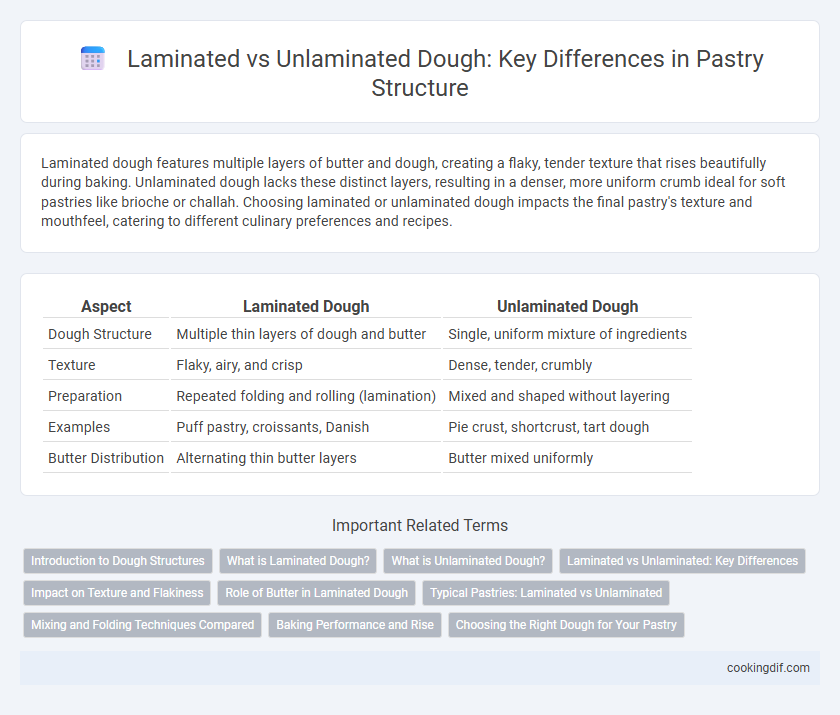Laminated dough features multiple layers of butter and dough, creating a flaky, tender texture that rises beautifully during baking. Unlaminated dough lacks these distinct layers, resulting in a denser, more uniform crumb ideal for soft pastries like brioche or challah. Choosing laminated or unlaminated dough impacts the final pastry's texture and mouthfeel, catering to different culinary preferences and recipes.
Table of Comparison
| Aspect | Laminated Dough | Unlaminated Dough |
|---|---|---|
| Dough Structure | Multiple thin layers of dough and butter | Single, uniform mixture of ingredients |
| Texture | Flaky, airy, and crisp | Dense, tender, crumbly |
| Preparation | Repeated folding and rolling (lamination) | Mixed and shaped without layering |
| Examples | Puff pastry, croissants, Danish | Pie crust, shortcrust, tart dough |
| Butter Distribution | Alternating thin butter layers | Butter mixed uniformly |
Introduction to Dough Structures
Laminated dough features multiple thin layers of butter folded between dough, creating a flaky, airy texture ideal for croissants and puff pastries. Unlaminated dough lacks these distinct layers, resulting in a denser, more uniform crumb typical of brioche or challah. The structural difference stems from lamination's mechanical layering process that traps steam, while unlaminated dough relies on yeast fermentation for rise and texture.
What is Laminated Dough?
Laminated dough is a type of pastry dough made by repeatedly folding and rolling layers of butter into the dough, creating multiple thin layers that result in a flaky, airy texture when baked. This technique contrasts with unlaminated dough, which lacks these distinct layers, producing a denser and more crumbly pastry. Laminated dough is essential for pastries like croissants and puff pastry, where the structure depends on steam generated between butter layers for rise and crispness.
What is Unlaminated Dough?
Unlaminated dough refers to pastry dough that lacks multiple layers of butter folded within, resulting in a denser, more uniform crumb compared to laminated dough. This type of dough, commonly used for pie crusts, tart shells, and some cookies, relies on solid fat incorporated directly into the flour to create a tender, flaky texture without the characteristic flakiness from layered butter. Unlike laminated doughs such as croissants or puff pastry, unlaminated doughs do not require repeated rolling and folding, making them simpler to prepare but offering less rise and flakiness.
Laminated vs Unlaminated: Key Differences
Laminated dough features multiple layers of butter and dough folded together, creating a flaky, airy texture ideal for croissants and puff pastries. Unlaminated dough lacks these layers, resulting in a denser, softer crumb often used for brioche or challah. The key difference lies in laminated dough's structured layering process that enhances crispiness and rise, while unlaminated dough emphasizes tenderness and uniform consistency.
Impact on Texture and Flakiness
Laminated doughs, such as puff pastry and croissants, achieve a flaky and layered texture due to repeated folding and rolling of butter within the dough, creating distinct layers that separate during baking. Unlaminated doughs, like brioche or challah, have a softer, more uniform crumb with a tender texture, as they lack the layered structure from butter lamination. The presence or absence of lamination directly impacts flakiness, with laminated doughs providing crisp, airy layers, whereas unlaminated doughs yield a denser, but softer bite.
Role of Butter in Laminated Dough
In laminated dough, butter plays a crucial role by creating multiple thin layers that separate the dough during baking, resulting in a flaky, airy texture that is characteristic of croissants and puff pastries. The high fat content in butter prevents gluten formation between layers, enhancing tenderness and promoting steam generation that puffs up the dough. In contrast, unlaminated doughs incorporate butter uniformly, producing a denser, more biscuit-like crumb without distinct layers or the same flaky structure.
Typical Pastries: Laminated vs Unlaminated
Laminated doughs, such as puff pastry, croissants, and Danish, are characterized by multiple thin layers of butter and dough that create a flaky, airy structure when baked. Unlaminated doughs, including biscuits, scones, and muffins, exhibit a denser, crumbly texture due to the lack of butter layering, relying instead on chemical leavening agents and minimal handling for rise. The choice between laminated and unlaminated dough directly impacts the final pastry's crumb, flakiness, and tenderness, making it crucial for achieving the desired texture and mouthfeel in traditional baked goods.
Mixing and Folding Techniques Compared
Laminated dough involves repeated folding and rolling to create distinct, flaky layers by incorporating thin sheets of butter between dough folds, resulting in a tender texture and crisp bite. Unlaminated dough relies on thorough mixing to develop a consistent gluten network, producing a denser, more uniform crumb without visible layers. The folding technique in laminated dough is crucial for lamination integrity, while unlaminated dough benefits from careful mixing time to optimize elasticity and rise.
Baking Performance and Rise
Laminated doughs, characterized by multiple layers of butter and dough, create a flaky texture through steam expansion, resulting in superior rise and crispness during baking. Unlaminated doughs, lacking these layers, produce a denser crumb with less rise but a tender, uniform structure ideal for softer pastries. The lamination process significantly enhances oven spring and volume, making it crucial for croissants and puff pastries but less essential for brioche or Danish pastries.
Choosing the Right Dough for Your Pastry
Laminated dough, characterized by multiple layers of butter and dough, creates a flaky, airy structure ideal for croissants and puff pastries. Unlaminated dough offers a denser, tender crumb suitable for tarts and shortbreads where a sturdier base is required. Selecting the right dough ensures the desired texture, with laminated dough providing crispness and lift, while unlaminated dough delivers richness and crumb stability.
Laminated vs Unlaminated for dough structure Infographic

 cookingdif.com
cookingdif.com